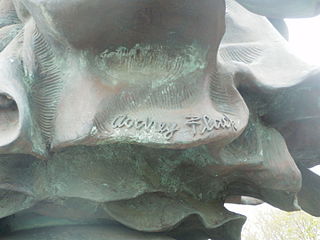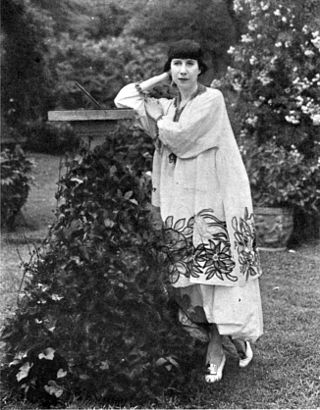Related Research Articles

Helen Frankenthaler was an American abstract expressionist painter. She was a major contributor to the history of postwar American painting. Having exhibited her work for over six decades, she spanned several generations of abstract painters while continuing to produce vital and ever-changing new work. Frankenthaler began exhibiting her large-scale abstract expressionist paintings in contemporary museums and galleries in the early 1950s. She was included in the 1964 Post-Painterly Abstraction exhibition curated by Clement Greenberg that introduced a newer generation of abstract painting that came to be known as color field. Born in Manhattan, she was influenced by Greenberg, Hans Hofmann, and Jackson Pollock's paintings. Her work has been the subject of several retrospective exhibitions, including a 1989 retrospective at the Museum of Modern Art in New York City, and been exhibited worldwide since the 1950s. In 2001, she was awarded the National Medal of Arts.

Josef Albers was a German-born American artist and educator who is considered one of the most influential 20th-century art teachers in the United States. Born in 1888 in Bottrop, Westphalia, Germany, into a Roman Catholic family with a background in craftsmanship, Albers received practical training in diverse skills like engraving glass, plumbing, and wiring during his childhood. He later worked as a schoolteacher from 1908 to 1913 and received his first public commission in 1918 and moved to Munich in 1919. In 1920, Albers joined the Weimar Bauhaus as a student and later became a faculty member in 1922, teaching the principles of handicrafts. With the Bauhaus's move to Dessau in 1925, he was promoted to professor and married Anni Albers, a student at the institution and a textile artist. Albers' work in Dessau included designing furniture and working with glass, collaborating with established artists like Paul Klee.

Color field painting is a style of abstract painting that emerged in New York City during the 1940s and 1950s. It was inspired by European modernism and closely related to abstract expressionism, while many of its notable early proponents were among the pioneering abstract expressionists. Color field is characterized primarily by large fields of flat, solid color spread across or stained into the canvas creating areas of unbroken surface and a flat picture plane. The movement places less emphasis on gesture, brushstrokes and action in favor of an overall consistency of form and process. In color field painting "color is freed from objective context and becomes the subject in itself."

Nancy Graves was an American sculptor, painter, printmaker, and sometime-filmmaker known for her focus on natural phenomena like camels or maps of the Moon. Her works are included in many public collections, including those of the National Gallery of Art, the Brooklyn Museum of Art, the Smithsonian American Art Museum, the National Gallery of Australia (Canberra), the Des Moines Art Center, Walker Art Center (Minneapolis), and the Museum of Fine Arts. When Graves was just 29, she was given a solo exhibition at the Whitney Museum of American Art. At the time she was the youngest artist, and fifth woman to achieve this honor.

Anni Albers was a German textile artist and printmaker credited with blurring the lines between traditional craft and art.
Besides surface qualities, such as rough and smooth, dull and shiny, hard and soft, textiles also includes colour, and, as the dominating element, texture, which is the result of the construction of weaves. Like any craft it may end in producing useful objects, or it may rise to the level of art.

Sheila Hicks is an American artist. She is known for her innovative and experimental weavings and sculptural textile art that incorporate distinctive colors, natural materials, and personal narratives.

Amy Sillman is a New York-based visual artist, known for process-based paintings that move between abstraction and figuration, and engage nontraditional media including animation, zines and installation. Her work draws upon art historical tropes, particularly postwar American gestural painting, as both influences and foils; she engages feminist critiques of the discourses of mastery, genius and power in order to introduce qualities such as humor, awkwardness, self-deprecation, affect and doubt into her practice. Profiles in The New York Times, ARTnews, Frieze, and Interview, characterize Sillman as championing "the relevance of painting" and "a reinvigorated mode of abstraction reclaiming the potency of active brushwork and visible gestures." Critic Phyllis Tuchman described Sillman as "an inventive abstractionist" whose "messy, multivalent, lively" art "reframes long-held notions regarding the look and emotional character of abstraction."

Audrey Flack is an American artist. Her work pioneered the art genre of photorealism and encompasses painting, printmaking, sculpture, and photography.

Joan Mitchell was an American artist who worked primarily in painting and printmaking, and also used pastel and made other works on paper. She was an active participant in the New York School of artists in the 1950s. A native of Chicago, she is associated with the American abstract expressionist movement, even though she lived in France for much of her career.

Florine Stettheimer was an American modernist painter, feminist, theatrical designer, poet, and salonnière.

Jennifer Bartlett was an American artist and novelist. She was best known for paintings and prints that combine the system-based aesthetic of conceptual art with the painterly approach of Neo-Expressionism. Many of her pieces were executed on small, square, enamel-coated steel plates that are combined in grid formations to create very large works.
Jane Davis Doggett was an American graphic artist and pioneer designer of wayfinding and graphics systems for airports.
Sarai Sherman was a Pennsylvania-born Jewish American artist whose work, both in America and Europe shaped international views of women and abstract expressionism. She was a significant twentieth century painter and sculptor known for her abstract paintings, prints and ceramics.

Loren MacIver was an American painter and the first woman represented in the Museum of Modern Art's permanent collection.
Pam Lins is an artist based in Brooklyn, NY. She refers to all of her work primarily as sculpture, although she uses the term expansively. Through it she contemplates the social, the political, and the historical by constructing situations inquisitive and equivocal to sculpture and the making of it. Her range of adoptive methods includes painting, producing jewelry, drawing cartoons, and growing mushrooms. She currently teaches at Cooper Union School of Art and Princeton University.

Nicole Awai is an artist and educator based in Brooklyn, New York and Austin, Texas. Her work captures both Caribbean and American landscapes and experiences and engages in cultural critique. She works in many media including painting, photography, drawing, installations, ceramics, and sculpture as well as found objects.

Victor George Kord is an American painter and educator. He currently maintains a studio and exhibits in New York City. He previously served as art department chair for several major universities, and remains professor emeritus of painting at Cornell University Department of Art.
Tomashi Jackson is an American multimedia artist working across painting, video, textiles and sculpture. Jackson was born in Houston, Texas, raised in Los Angeles, and currently lives and works in New York, NY and Cambridge, MA. Jackson was named a 2019 Whitney Biennial participating artist. Jackson also serves on the faculty for sculpture at Rhode Island School of Design. Her work is included in the collection of MOCA Los Angeles. In 2004, a 20-foot-high by 80-foot-long mural by Jackson entitled Evolution of a Community was unveiled in the Los Angeles neighborhood of West Adams.
Hangama Amiri is an Afghan-Canadian feminist artist, who works in painting and video. Amiri's work has been exhibited in Canada in cities including Halifax, Vancouver, Toronto and Lunenburg. Internationally, her work has appeared in New York, London, Hong Kong, Italy, France, Morocco and Venice.

Norman Seaton Ives (1923–1978) was an American artist, graphic designer, educator, and fine art publisher. He co-founded Ives-Sillman, Inc. alongside Sewell Sillman, which published silkscreen prints and photographs in monographic art portfolios.
References
- 1 2 3 4 5 6 7 8 9 10 11 12 "Oral history interview with Victoria Barr, 1977 January 11-February 18". www.aaa.si.edu. Retrieved 2020-05-22.
- ↑ Barr, Victoria (2019-09-20). "Kuta Beach, Bali 1977 (Set of 61)". Artist and Gallery Ephemera.
- ↑ "Stephen Spector, 49, Dead; Art Consultant and Collector".
- ↑ Glueck, Grace (1981-08-16). "Alfred Hamilton Barr Jr. Is Dead; Developer of Modern Art Museum". The New York Times. ISSN 0362-4331 . Retrieved 2020-05-22.
- ↑ "Kasha Linville on Victoria Barr". www.artforum.com. Retrieved 2020-05-22.
- ↑ Yau, J (August 1981). "Victoria Barr at Haber Theodore {New York; exhibit}". Art in America. 69: 147–148 – via Art & Architecture Resource.
- ↑ "Victoria Barr | Surfacing". whitney.org. Retrieved 2020-05-22.
- ↑ Barr, Victoria (2019-09-20). "Kuta Beach, Bali 1977 (Set of 61)". Artist and Gallery Ephemera.